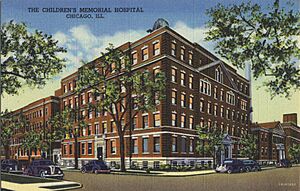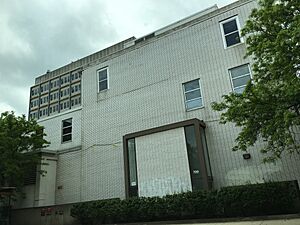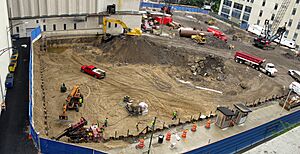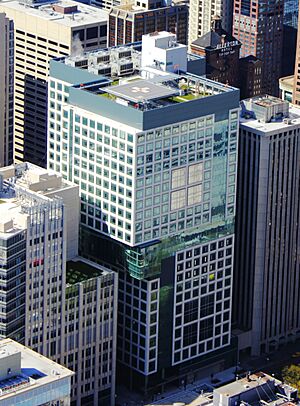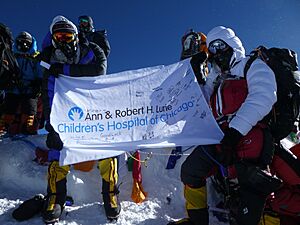Lurie Children's Hospital facts for kids
Quick facts for kids Ann & Robert H. Lurie Children's Hospital of Chicago |
|
|---|---|
 |
|
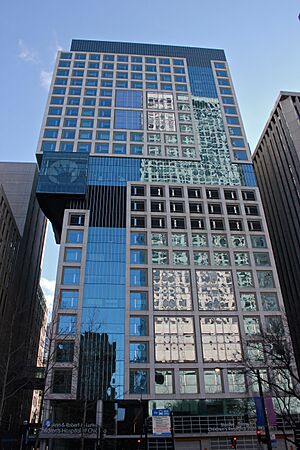 |
|
| Geography | |
| Location | 225 East Chicago Avenue, Chicago, Illinois, United States |
| Coordinates | 41°53′47″N 87°37′19″W / 41.89639°N 87.62194°W |
| Organization | |
| Funding | Non-profit hospital |
| Hospital type | Teaching |
| Affiliated university | Northwestern University Feinberg School of Medicine |
| Services | |
| Emergency department | Level 1 Pediatric Trauma Center |
| Helipad | (FAA LID: 75IS) |
| Beds | 312 |
| Speciality | Children / Pediatrics |
| History | |
| Founded | 1882 |
Ann & Robert H. Lurie Children's Hospital of Chicago, also known as Lurie Children's, is a top children's hospital in Chicago, Illinois. It used to be called Children's Memorial Hospital. This hospital is special because it focuses on helping babies, kids, teens, and young adults up to age 21.
Lurie Children's has 360 beds and works closely with Northwestern University Feinberg School of Medicine. It offers many different types of care for children. The hospital also has a special Level 1 Pediatric Trauma Center, which means it's ready for the most serious emergencies. It works with nearby Northwestern Memorial Hospital and Prentice Women's Hospital. Lurie Children's has over 1,665 doctors and 4,000 employees. It even has a helipad on its roof to bring very sick children to the hospital quickly.
The hospital offers 70 different types of care for kids. In 2018, doctors and staff helped over 212,000 children. These children came from 48 states and 49 countries around the world.
In the 2019–2020 U.S. News & World Report rankings, Lurie Children's was named the best children's hospital in Illinois. It ranked high in all 10 special areas of care.
Contents
A Look at Lurie Children's History
How It All Started
The hospital began in 1882 as the Maurice Porter Memorial Hospital. It was a small cottage with 8 beds for children aged 3 to 13. A nurse and mother named Julia Foster Porter started it after her 13-year-old son passed away. The first hospital was on Halsted and Belden streets in Chicago. Today, a building for DePaul University stands there, with a special plaque.
In 1884, Julia Porter bought another building nearby. She built a new three-story hospital with 22 beds. By 1896, the hospital grew again, able to care for 50 children.
In 1903, a big gift allowed Porter to buy a piece of land in Chicago's Lincoln Park neighborhood. A new Maurice Porter Children's Hospital was built there. It stayed in that spot for 130 years.
Growing and Changing Names
In 1904, the hospital changed its name to Children's Memorial Hospital (CMH). A few years later, in 1907, a local helper named John Borland gave the hospital an X-ray machine.
By 1908, the hospital could hold 108 beds. This was after the "Cribside Pavilion" opened, which also allowed babies to be admitted for the first time. In 1912, CMH expanded again, reaching 175 beds. People in the community gave money to help the hospital. This allowed them to keep providing free care to children.
In 1926, CMH built the "Martha Wilson Memorial Pavilion." This brought the total beds to 272. They also built a place for nurses and interns to live.
In the 1940s, doctors at CMH started one of the first children's surgery programs in the country. Surgeons Willis J. Potts and Sidney Smith created new tools and a new surgery. This surgery helped treat a condition called blue baby syndrome.
In 1957, CMH decided to build a new, modern hospital. Demolition started in 1960 to make way for new patient rooms, research areas, and offices. The new patient tower opened on October 11, 1962. The research tower opened in 1963. In the 1960s, CMH also created one of the first pediatric intensive care units (PICU) with 10 beds.
In June 1979, Ray Kroc, who helped make McDonald's famous, gave money to the hospital. This helped build a new three-story building. It was named the "Ray A. Kroc Diagnostic and Treatment Center." It had new operating rooms, a 25-bed emergency department, and an X-ray area.
In 1982, CMH added four more floors to the main hospital building. One of these floors became a special care unit for newborns. A new helipad was also added to the roof. In the same year, CMH doctors successfully separated conjoined twins. The operation took nine hours.
In 2006, the hospital announced plans for a brand new children's hospital. It would be closer to downtown Chicago and Northwestern University. After the move, the old buildings were empty for years. Demolition of the former Children's Memorial Hospital began in 2016. This made space for new apartments and shops.
A New Home for Kids
On June 9, 2012, the hospital moved to its current location in Streeterville. It was a big move, with 200 children traveling by ambulance. The move took over 10 hours. The hospital also changed its name to Ann & Robert H. Lurie Children's Hospital of Chicago. This new name honored Ann Lurie and her late husband. Ann Lurie gave $100 million in 2007 to help build the new hospital and support research. This was the largest gift the hospital had ever received.
The move helped the hospital be closer to its partner, Northwestern University Feinberg School of Medicine. This helps doctors and researchers work together better. It also makes it easier for babies from nearby Prentice Women's Hospital to get quick care.
The new building cost $605 million and was finished in June 2012. It has 23 floors. The design included many new ideas for hospitals. For example, the emergency room is on the second floor. The new hospital is almost twice as big as the old one. It has outdoor spaces, playrooms, and private patient rooms. The hospital's design has been praised in many publications. It also has terraces with plants and trees to help patients and families feel calm.
In October 2014, the hospital started its "Hope and Courage awards." These awards honor people who have done great things to help children.
In 2016, Lurie Children's announced plans for a $51 million expansion. This would add 44 more intensive care beds for children and four for newborns. The hospital needed more beds because it was often full.
In 2019, Alex Pancoe, who was treated at Lurie Children's for a brain tumor, started a fundraiser. He climbed Mount Everest to raise $1 million for the hospital.
In March 2020, Lurie Children's Hospital helped other hospitals during the 2020 COVID-19 pandemic. They took in children from other hospitals. This allowed adult hospitals to use their beds for adult patients with COVID-19. In April 2020, Lurie Children's also loaned out many of its breathing machines to adult hospitals.
In December 2020, doctors at Lurie Children's used a new gene therapy. They treated a baby with a muscle-weakening disease called type 1 spinal muscular atrophy. In early 2021, Lurie Children's and Rush University Medical Center (RUMC) teamed up. They formed a partnership to provide better care for children in the area.
About Lurie Children's
Learning and Teaching
Lurie Children's is the main teaching hospital for children's health at Northwestern University Feinberg School of Medicine. It has programs for doctors who are still learning. The Feinberg School is highly ranked for its research and primary care programs.
Important Research
The hospital has had a special research program for children since 1982. It was first called the Children's Memorial Research Center. More research floors were added in 2004.
When the hospital moved in 2012, the research part was renamed the Lurie Children's Research Institute. In 2014, a helper named Stanley Manne gave a gift. The research institute was then renamed the Stanley Manne Children's Research Institute to honor him. In 2019, the institute moved to a new location at Northwestern University.
Patient Care Areas
Ann & Robert H. Lurie Children's Hospital of Chicago has many different areas to care for children and young adults.
- 48 beds for general medical care
- 40 beds in the pediatric intensive care unit (PICU)
- 48 beds for children with blood disorders and cancer
- 44 beds for heart care
- 64 beds in the neonatal intensive care unit (NICU) for newborns
- 45 beds in the emergency department
- 23 beds for before and after surgery
- 12 beds in the psychiatric unit for ages 3–17
The hospital also has 21 operating rooms. There is a "sky garden" to help families relax.
Ronald McDonald House
The Ronald McDonald House Near Lurie Children's Hospital (RMCH) opened in 2012. It is about five blocks from the hospital. This house has 70 private rooms for families of children being treated at Lurie Children's. It also helps families of babies at Prentice Women's Hospital and rehabilitation patients. The house offers places to sleep, meals, and fun activities for free. Lurie Children's also has a Ronald McDonald family room inside the hospital. It has nine sleep rooms, showers, and other comforts for families.
Ronald McDonald House History
Before Lurie Children's moved, the old Children's Memorial Hospital had a 21-room RMCH nearby. When Lurie Children's moved, a new 14-story RMCH was built. It cost $40 million. Nine rooms were also built inside the new Lurie Children's building. The old house was later taken down. In August 2018, a company called AbbVie gave $100 million to Ronald McDonald House charities across the country. $3 million of that went to the Chicago houses. In November 2019, the house added four more rooms to help more families. In August 2020, the house had some minor damage during a local event. Families inside were kept safe.
Awards and Special Recognitions
- In 2001, the hospital received its first "Magnet designation." This award recognizes excellent nursing care. It received it again in 2005, 2010, and 2015. Very few hospitals get this award three or more times.
- When the new Lurie Children's Hospital opened in 2012, it earned a "LEED Gold" award. This means the building is very environmentally friendly. It has a green roof and manages rainwater well.
- In 2012, the magazine Modern Healthcare gave the hospital a design award. This was for its advanced design and construction.
- The hospital is one of only 10 children's hospitals in the U.S. to be named a "Top Hospital" for patient safety by The Leapfrog Group.
- The Joint Commission, which checks healthcare organizations, named the hospital one of the top performers for quality.
- In 2014, Becker's Hospital Review listed the hospital as one of the "150 Great Places to Work in Healthcare."
- In July 2016, the hospital became the first children's hospital in Illinois to be a "level 1 pediatric surgery center." This is a special recognition from the American College of Surgeons.
- In both 2019 and 2020, Forbes magazine named Lurie Children's Hospital a "best midsize employer" and a "best employer in Illinois." In 2020, it was also recognized for its advanced use of technology.
U.S. News Rankings
Lurie Children's Hospital has been highly ranked by U.S. News & World Report for many years.
- In 2007–08, it was ranked #25 among children's hospitals in the U.S.
- In 2010–11, it was ranked in the top 20 for many specialties, including cancer, heart care, and brain surgery.
- In 2016–17, it was one of only 11 children's hospitals to make the "Honor Roll."
- In 2018–19, it was ranked the #10 best children's hospital in the country.
- As of 2021, Lurie Children's has placed nationally in all 10 ranked pediatric specialties.
| Specialty | Rank (In the U.S.) | Score (Out of 100) |
|---|---|---|
| Neonatology | #8 | 91.3 |
| Pediatric Cancer | #14 | 83.4 |
| Pediatric Cardiology & Heart Surgery | #8 | 86.8 |
| Pediatric Diabetes & Endocrinology | #32 | 69.2 |
| Pediatric Gastroenterology & GI Surgery | #14 | 85.7 |
| Pediatric Nephrology | #12 | 82.9 |
| Pediatric Neurology & Neurosurgery | #11 | 86.5 |
| Pediatric Orthopedics | #35 | 69.9 |
| Pediatric Pulmonology & Lung Surgery | #21 | 78.4 |
| Pediatric Urology | #7 | 84.5 |
People Who Helped Lurie Children's
Many important people have worked at or been connected to Lurie Children's Hospital.
- Robert Satcher – A former doctor and NASA Astronaut.
- Susan L. Cohn – A doctor who specializes in children's cancer.
- John F Sarwark – The head of children's bone and joint care at Lurie Children's.
- Willis J. Potts – A doctor who helped start one of the first children's surgery programs.
- Orvar Swenson – A former chief surgeon at Children's Memorial Hospital.
- Frank Spooner Churchill – President of the medical staff at Children's Memorial Hospital from 1909 to 1917.
- Stephen Dolgin – An American children's surgeon.
- Wolf W. Zuelzer – A children's disease expert.
- Rebekah D. Fenton – An American doctor who works with teens and young adults.
- Marc Weissbluth – An American children's doctor and author.
- George J. Mohr – Completed his children's doctor training at the hospital.
- Nadia Dowshen – An American children's doctor.
- Ellen Sidransky – An American children's doctor.
See Also
- List of children's hospitals in the United States
- Children's Hospital of Philadelphia
- Northwestern Memorial Hospital
- Advocate Children's Hospital



